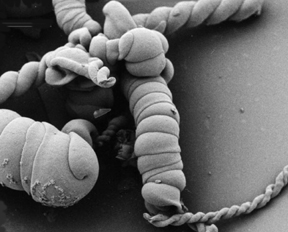
Geotimes Home | AGI Home | Information Services | Geoscience Education | Public Policy | Programs | Publications | Careers

 A laboratory
experiment has given rise to tiny filaments that mimic structures found in ancient
rocks identified as microfossils. The findings cast further doubt over whether
the oldest known microfossils found in the 3.5-billion-year-old Warrawoona Group
in Australia were indeed produced by living organisms, with implications for the
search for early life on Earth and elsewhere.
A laboratory
experiment has given rise to tiny filaments that mimic structures found in ancient
rocks identified as microfossils. The findings cast further doubt over whether
the oldest known microfossils found in the 3.5-billion-year-old Warrawoona Group
in Australia were indeed produced by living organisms, with implications for the
search for early life on Earth and elsewhere. |
Geotimes Home | AGI Home | Information Services | Geoscience Education | Public Policy | Programs | Publications | Careers |